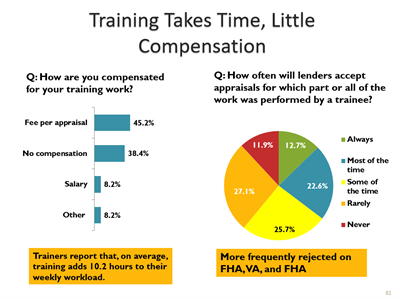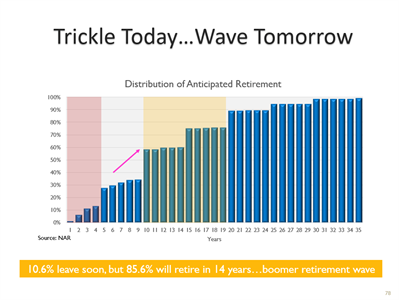IN AN EFFORT to understand the window of opportunity in a transaction for Realtors® and appraisers to discuss a property, the Northern Virginia Association of Realtors® and the National Association of Independent Fee Appraisers host an annual NVAR Appraisal Summit, which began 12 years ago. Although appraisers’ and Realtors®’ points of view may differ, the summit serves as an invaluable outlet to bring professionals together to network and discuss industry trends, changes and challenges.
MARKET OVERVIEW
After a welcome from 2017 NVAR Chairman Bob Adamson and an introduction by moderator Jamie Loizou, co-owner at Suburban Appraisers and Consultants, this year’s November 13 summit opened with a nationwide and local overview of the real estate market, delivered by NVAR CEO Ryan Conrad.
He explained that homeownership is still near 50-year lows. Housing continues to be less affordable and there is a low supply of inventory. However, despite affordability issues, mortgage rates are relatively unchanged while there is steady growth in existing home sales, he said.
Conrad noted there are more young adults living with their parents, which could be related to increased levels of student debt.
Focusing on the local region, he highlighted recent job growth. Home sales and prices are up, but inventory is low in the region, which mirrors the national trend.
“We have some catch-up to do,” Conrad said. “Our market isn’t necessarily outperforming as it was years ago, but we expect growth to continue.”
WHAT GOT US HERE?
John Russell, senior director of government relations and chief lobbyist for the American Society of Appraisers, discussed initiatives that explain the current state of the industry.
Before the Financial Institutions Reform, Recovery, and Enforcement Act of 1989 (FIRREA), there were no minimum qualifications to identify oneself as an appraiser. Title XI of FIRREA required states to institute an appraiser licensing and certification system for federally related transactions.
However, in 1994, bank regulatory agencies exempted some appraisal activity from Title XI’s requirements.
Russell said this was not necessarily an effort to skirt Title XI’s requirements, but rather to avoid duplicated efforts – since the requirements of the exempted entities were already known to exceed those imposed by Title XI.
Then came the 2007 housing collapse.
“Nothing can capture what happened quite like a dumpster fire,” Russell said. “We all wore it. We were all part of the problem. We all engaged in activity that contributed to this dumpster fire.”
After the collapse, people tried to fix problems by swinging the pendulum in the opposite direction, which is where the Home Valuation Code of Conduct (HVCC) came into play, explained Russell.
The HVCC was interpreted by most lenders to require an Appraisal Management Company (AMC) to act as a firewall between the lender and the appraiser.
“HVCC, for better or worse, took away the relationship part of your business.” Russell said. “In addition, there was more work for less money. A lot of really good appraisers decided, ‘why am I going to keep doing this if it doesn’t make sense to me as a business person?’”
Title XIV of the Dodd-Frank Act of 2010 was an attempt to remedy some of the issues that arose with AMCs, but AMCs continue to be a point of conflict in the appraisal process.
“Seven years later, we are not done implementing Title XIV,” Russell said.
THE FUTURE OF VALUATION
Panelists discussed the perceived shortage of appraisers and possible causes of this trend, along with other challenges in the industry.
“Appraiser shortage is due to one word and one word only: economics,” Pat Turner, president of the Old Dominion Chapter of NAIFA and president of the Virginia Coalition of Appraisal Professionals, said.
In recent years, the industry has created significant barriers for appraisers to enter the field. Individuals must take appraisal coursework and have experience to become an appraiser, but compared to past requirements and other industry professions, appraisers must also have a four-year degree.
Once an appraiser becomes certified, he or she still needs to be trained, requiring appraisers to share the income with a trainee in the field. Further, many lenders refuse to accept appraisals that are performed by trainees.

Slide presented by Ken Fears during the Summit; data from the NAR Appraiser Trends Study.
Appraisers are required by the Uniform Standards of Professional Appraisal Practice (USPAP) to have geographical competency in the area they are working in, which means they must have knowledge of the area’s market. If appraisers do not have geographical competency, they may make an inaccurate appraisal. Turner discussed how this is an issue, as AMCs sometimes choose appraisers from outside the region who charge less.
Ken Fears, director of regional economics and housing finance at the National Association of Realtors®, said another reason for the shortage of appraisers is the trend that many are retiring. According to the NAR Appraiser Trends Study, the average age of an appraiser is 54 years old and 10 years from now, 58 percent of appraisers will move out of the industry. He added that it is not just because of AMCs that there is a shortage of appraisers, but that many are opting out of specific types of assignments.

Retirement distribution as presented by Ken Fears from the National Association of Realtors®.
As the industry changes and moves behind computer screens, Turner doubted the value of automation over an appraiser visiting a property in person.
“I’ve said this over and over again: How many computers can see? How many computers can hear or smell?” Turner said.
Despite these factors, panelists seemed optimistic about the future of appraisers.
“I see this as the cup being half full, not half empty, because I think the economics are going to change,” Turner said. “As for the future of appraisers, I am not ready to say that it is doom and gloom.”